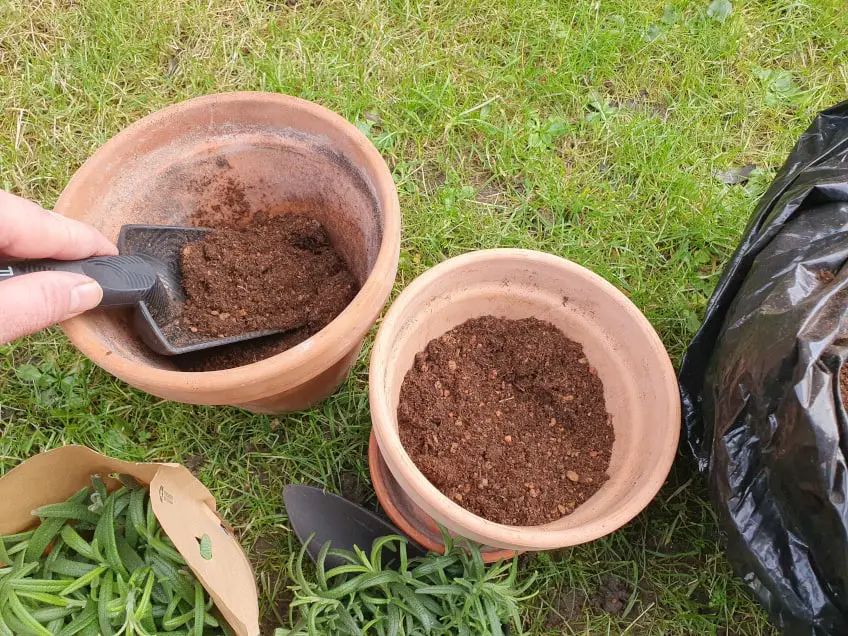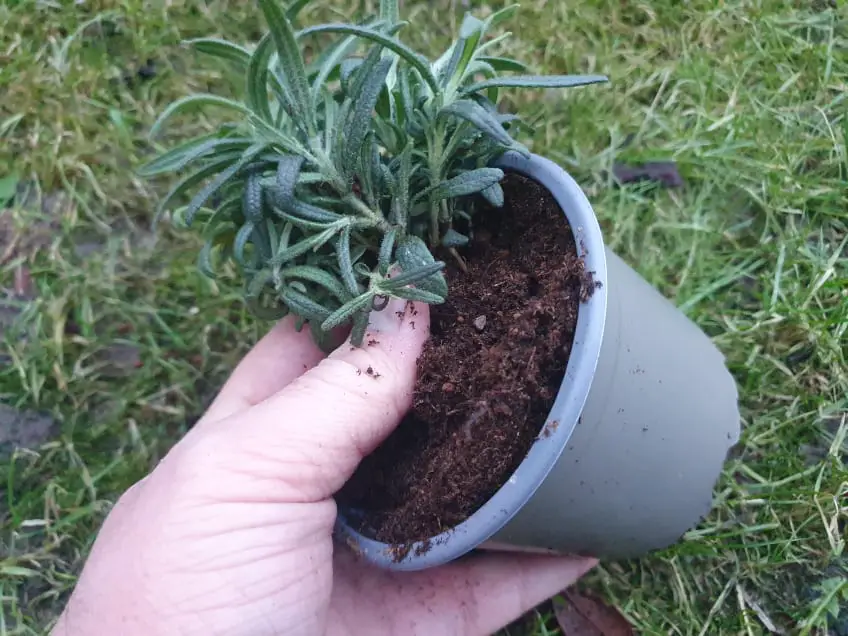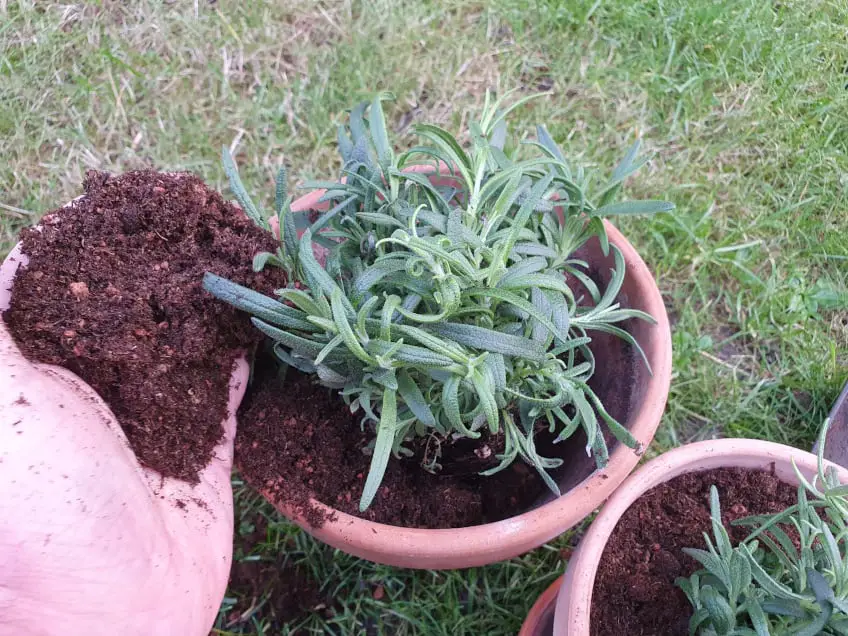If your rosemary has outgrown its pot or you just want to move it somewhere else, either to another pot or into the ground, you should know how to transplant it, which is precisely what I cover in this article.
You can use transplanting to move your rosemary to other pots, transfer it from a pot into the ground, or the other way around. Regardless of what you want to do, I explain what you need to know in this guide.
I went out and bought a couple of rosemary plants so I could transplant them into some larger pots and take photos of every step since that is what people most often ask me about. I explain everything you need to know no matter where you want to transplant your rosemary to and from, though. Let’s get into it.
1: Get Your Rosemary, Soil, Hand Trowel, Water, and a Pot

Transplanting rosemary is a relatively simple process that doesn’t require a lot of tools or equipment, but you need a couple of things and you can save yourself some time if you find all of them from the beginning.
Get the rosemary plant you want to transplant, some soil, a hand trowel if you have one, some water, and a pot. You don’t need the pot if you are transplanting your rosemary into the ground.
The best soil for rosemary is slightly acidic, loamy soil that drains well. I have found that adding sand or small pebbles to the soil mix can help improve drainage.
If you are transplanting your rosemary into another pot, make sure it has one or more drainage holes at the bottom since good drainage is crucial for rosemary. I usually use terra cotta pots like the ones in my photo above since the material allows water to escape more easily and improves the soil’s ability to “breathe”.
A hand trowel is not necessary if you are repotting your rosemary and don’t mind getting your hands a bit dirty, but if you are transplanting it into the ground, you need it to dig a hole (or you can use a shovel or similar). I have this hand trowel (link to Amazon), which you can see in my photo above, and I am very pleased with them.
2: Prepare the New Pot or Dig a Hole in the Ground

The next step is to prepare the pot or the spot in the ground where you want to put your rosemary.
If you are transplanting your rosemary to another pot you should put a bit of soil at the bottom of the pot as I have done in the photo above. The amount of soil depends on the pot and plant but the golden rule of thumb is that the base of the plant should be just below the top of the pot when you place it on the soil.
If you are planting your rosemary in the ground you need to dig a hole where your plant will fit and where the base of the plant is approximately at the same level as the surface of the ground. I prefer to dig a hole that is a bit wider than needed to make it easier to fit the plant. You will fill any excess space with soil in a bit.
Where in your garden (or indoors) you plant your rosemary matters a lot. If you aren’t sure where the best place to plant it is, I recommend that you take a look at the article on this link, where I explain how you can find out.
3: Remove Your Rosemary From Its Old Pot or Place

Now that the new pot or hole in the ground is ready, you need to remove your rosemary from its old pot or spot.
If your rosemary is growing in the ground you need to dig it up. It is easy to accidentally cut some of the roots when you dig around the plant, so it is better to dig a bit too wide and deep to avoid damaging the roots. You can always remove some of the excess soil afterward if needed.
If your rosemary is growing in a pot, you need to carefully take it out. In my experience, the safest way to do it without damaging the plant or the roots is to grab the plant at the base and then carefully pull until the pot releases it. If your plant is growing in a plastic pot, like the two plants I bought for this article, you can squeeze the pot a little bit to make it release the plant easier.
If you got your rosemary from a supermarket or it has just outgrown the pot it is in, there is a high chance that the roots are almost out of space. In that case, it can be a good idea to massage them gently to make them a bit looser after you remove it from its pot. This will help the roots spread and grow in the new spot.
4: Place Your Rosemary in Its New Pot or Spot and Add Soil

It is time to put your rosemary in its new pot or into the ground. This step is the same no matter if you are planting your rosemary in a pot or in the ground.
All you have to do is to place your rosemary in the new pot or the hole you have dug in the ground. For potted rosemary, I recommend using a large pot since that will allow your rosemary to grow big. You can read more about how large rosemary plants can actually get on this link as well as what factors, including pot size, affect the size of the plant.
While holding the plant at the base, fill the pot or hole in the ground with soil around the plant. I like to keep one hand on the plant like this as it makes it easier to adjust or move the plant a bit if needed as you fill the excess space with soil.
You can use a hand trowel or similar for this, but you can also just use your hands if you don’t mind getting a bit dirty. As you can see in the photo above, I just used my hands since I find it easier for this part.
5: Water Your Rosemary if the Soil Feels Dry

You’re done transplanting your rosemary. Good work! The only thing you might have to do now is to water the plant.
Rosemary is very easy to overwater, though, so you should only water yours if the soil feels dry to the touch. It is important that you don’t let the soil dry out all the way through but only allow the top to dry out. I took the photo above a while after I put the rosemary in that pot because it didn’t need water right away.
The easiest way to tell if rosemary needs to be watered is to touch the top of the soil. If it feels dry, give the plant a bit of water and if it feels wet or moist, don’t.
I have a guide where I explain how to water your specific rosemary, depending on where and how you grow it, how large it is, how the weather is, and more. You can find the guide on this link.
A really cool trick you can use for potted rosemary (but not rosemary that grows in the ground) is to water it from the bottom as I do in the photo above. There are several advantages to this, but the primary advantage is that it helps the roots grow better, which results in the whole plant doing better.
You can read more about how to bottom water your rosemary and why it is such a good idea in the article on this link.

